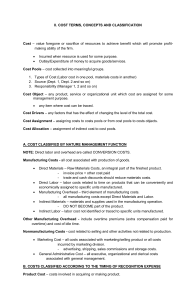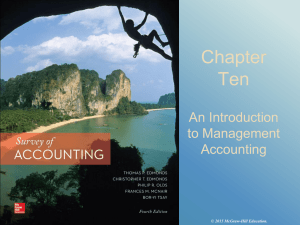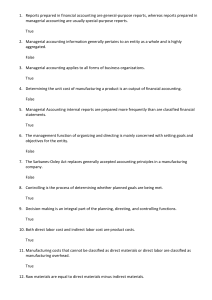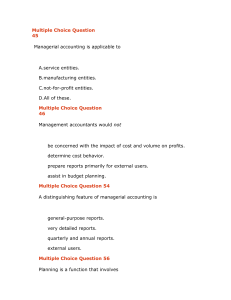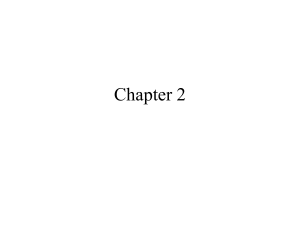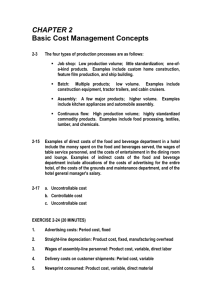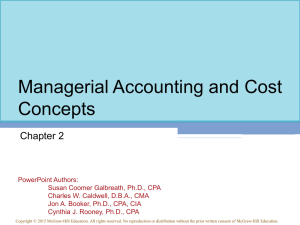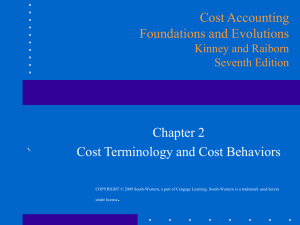Cost Object
advertisement
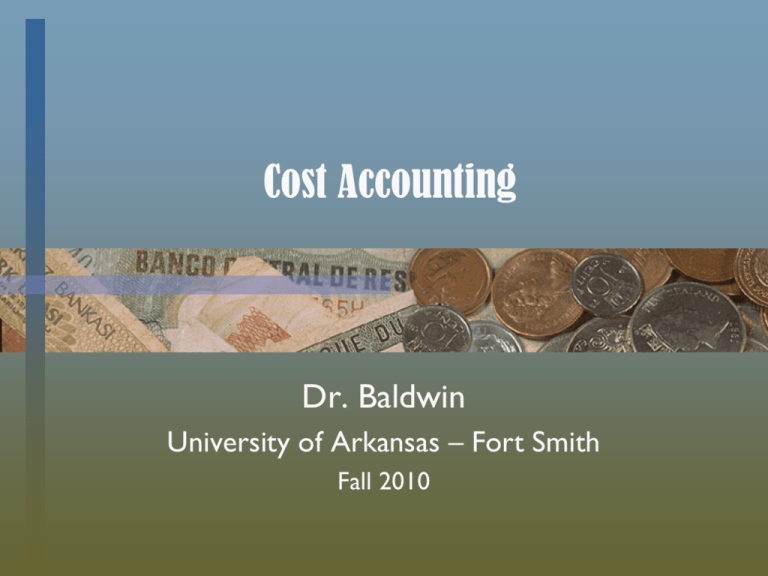
Cost Accounting Dr. Baldwin University of Arkansas – Fort Smith Fall 2010 CHAPTER 2 An Introduction to Cost Terms and Purposes Basic Cost Terminology • Cost – resource sacrificed to achieve a specific objective • We accumulate costs via cost objects – – – – activities or processes outputs of processes parts of an organization customers Basic Cost Terminology • Cost – resource sacrificed to achieve a specific objective – Actual Cost - a cost that has occurred – Budgeted Cost - a predicted cost • Cost Object – anything of interest for which a cost is desired • • • • activities or processes outputs of processes parts of an organization customers Basic Cost Terminology • Cost Accumulation – An organized collection of cost data • Cost Assignment – a general term that includes gathering accumulated costs to a cost object such as • Tracing accumulated costs with a direct relationship to the cost object and • Allocating accumulated costs with an indirect relationship to a cost object Direct and Indirect Costs • Direct Costs – can be conveniently and economically traced (tracked) to a cost object – Examples: Parts, assembly line wages • Indirect Costs – cannot be conveniently or economically traced (tracked) to a cost object. Instead of being traced, these costs are allocated to a cost object in a rational and systematic manner – Examples: Electricity, rent, property taxes Factors Affecting Direct/Indirect Cost Classification • Cost Materiality • Availability of Information-Gathering Technology • Operational Design Cost Behavior Variable Costs – changes in total in proportion to changes in the related level of activity or volume • Fixed Costs – remain unchanged in total regardless of changes in the related level of activity or volume • Costs are fixed or variable only with respect to a specific activity or a given time period • We must understand what drives the costs up or down over time. Cost Behavior, continued • Variable costs – are constant on a per-unit basis. • If a product takes 5 pounds of materials each, it stays the same per unit regardless of whether one, ten, or a thousand units are produced • Fixed costs – change inversely with the level of production. • As more units are produced, the same fixed cost is spread over more and more units, reducing the cost per unit Cost Behavior Summarized Total Dollars Variable Costs Change in proportion with output Cost per Unit Unchanged in relation to output More output = More total variable cost Fixed Costs Unchanged in relation to output Change inversely with output More output = lower cost per unit Other Cost Concepts • Cost Driver – a variable that causally affects costs over a given time span • Relevant Range – the band of normal activity level (or volume) in which there is a specific relationship between the level of activity (or volume) and a given cost • For example, fixed costs are fixed only within the relevant range. A Cost Caveat • Unit costs should be used cautiously. Since unit costs may change with a different level of output or volume, it may be more prudent to base decisions on a total dollar basis. Different Types of Firms • Manufacturing-sector companies – create and sell their own products • Merchandising-sector companies – product resellers • Service-sector companies – provide services Types of Inventories • Direct Materials – resources in stock and available for use • Work-in-Process (or progress) – – products started but not yet completed. Often abbreviated as WIP • Finished Goods – products completed and ready for sale Types of Product Costs • Direct Materials • Direct Labor • Indirect Manufacturing Costs – factory costs that are not traceable to the product. – Also known as Manufacturing Overhead costs or Factory Overhead costs Other Cost Considerations*** • Prime cost is a term referring to all direct manufacturing costs (labor and materials) • Conversion cost is a term referring to direct labor and factory overhead costs, collectively • Overtime labor costs are considered part of overhead *** Distinctions Between Costs • Inventoriable Costs (Product Costs) – product manufacturing costs. These costs are capitalized as assets (inventory) until they are sold and transferred to Cost of Goods Sold • Period Costs – have no future value and are expensed as incurred Cost Flows • The Cost of Goods Manufactured and the Cost of Goods Sold section of the income statement are accounting representations of the actual flow of costs through a production system. – Note the importance of inventory accounts in the following accounting reports, and in the cost flow chart Cost of Goods Manufactured Cellular Products Schedule of Cost of Goods Manufactured For the Year Ended December 31, 2007 (in thousands) Direct Materials: Beginning Inventory, January 1 $ 11,000 Add: Purchases 73,000 Cost of Direct Materials Available for Use 84,000 Less: Ending Inventory, December 31 8,000 Direct Materials Used 76,000 Direct Labor 9,000 Manufacturing Overhead: Indirect Labor 7,000 Supplies 2,000 Heat, Light & Power 5,000 Depreciation - plant building 2,000 Depreciation - plant equipment 3,000 Miscellaneous 1,000 Total Manufacturing Overhead Costs 20,000 Manufacturing costs incurred during 2007 105,000 Add: Beginning WIP, January 1 6,000 Total Manufacturing Costs to account for 111,000 Less: Ending WIP, December 31 7,000 Cost of Goods Manufactured $ 104,000 Calculates the cost of Direct Materials Used Accumulates the three product costs for the current period Adjusts the current period manufacturing costs to account for units actually completed Income Statement Cellular Products Income Statement For the Year Ended December 31, 2007 (in thousands) Revenues Cost of Goods Sold Beginning Finished Goods, January 1 Cost of Goods Manufactured Cost of Goods Available for sale Ending Finished Goods, December 31 Cost of Goods Sold Gross Profit Operating Costs: Marketing, distribution, and customer-service Total operating costs Operating Income $210,000 22,000 104,000 126,000 18,000 108,000 102,000 70,000 70,000 $32,000 Figure carries forward from the Schedule of Cost of Goods Manufactured Period Costs are expensed as incurred Cost Flowchart Income Statement Balance Sheet Direct Materials Purchases Inventoriable Costs Stored Direct Materials Inventory Re Other Direct Manufacturing Costs Manufacturing Overhead Costs Revenues io isit qu ne d De du ct Incurred Work-inProcess Inventory Completed Finished Goods Inventory Sold Cost of Goods Sold Applied rg i Ma s s ro duct ls G n de a u Eq The n R&D Costs Design Costs Marketing Costs Distribution Costs Customer-Service Costs Equals Operating Income Period Costs Different Definitions of Cost for Different Applications • Pricing and product-mix decisions – may use a “super” cost approach (comprehensive) • Contracting with government agencies – very specific definitions of cost for “cost plus profit” contracts • Preparing external-use financial statements – GAAP-driven product costs only Three Common Features of Cost Accounting and Cost Management • Calculating the cost of products, services, and other cost objects • Obtaining information for planning and control, and performance evaluation • Analyzing the relevant information for making decisions End of Chapter 2 • Now, let’s do some homework! – Woohoo! – :o)
